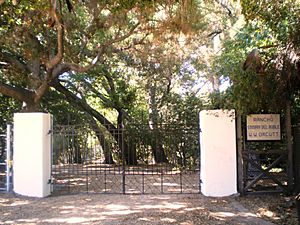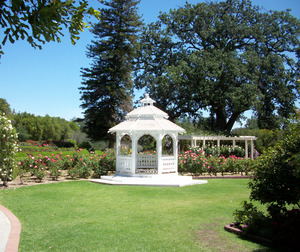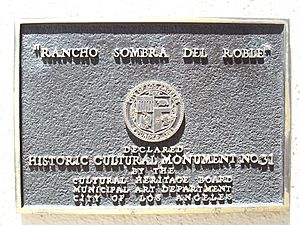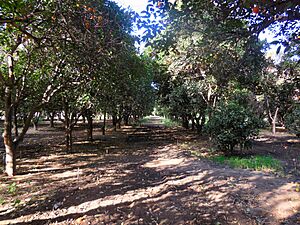Orcutt Ranch Horticulture Center facts for kids
Quick facts for kids Orcutt Ranch Horticulture Center |
|
|---|---|

Orcutt Ranch gate, September 2008
|
|
| Location | 23555 Justice Street, West Hills, Los Angeles, California, USA |
| Area | 210-acre (0.85 km2) |
| Built | 1903 |
| Architectural style(s) | Spanish Colonial Revival Style |
| Governing body | City of Los Angeles Dept. of Recreation and Parks |
| Designated | January 22, 1965 |
| Reference no. | 31 |
| Lua error in Module:Location_map at line 420: attempt to index field 'wikibase' (a nil value). | |
The Orcutt Ranch Horticulture Center is a special place in West Hills, Los Angeles, California, USA. It's also known by its Spanish name, Rancho Sombra del Roble. This ranch is so important that it's been named a Los Angeles Historic-Cultural Monument, which means it's a protected historical site.
Contents
The Story of Orcutt Ranch
Orcutt Ranch was once the vacation and retirement home of William Warren Orcutt. He was an important person in California's early oil industry. Mr. Orcutt also helped discover some of the first ancient animal skeletons at the famous La Brea Tar Pits.
A Ranch of Shaded Oaks
The ranch's Spanish name, Rancho Sombra del Roble, means "Ranch of the Shaded Oak." It started as a large 210-acre (0.85 km2) property. This land was used for raising cattle and growing citrus fruits. It was located right at the base of the Simi Hills.
William Orcutt bought this beautiful property in 1917. He then hired an architect named L.G. Knipe to design his home. Knipe also designed some of the first buildings at Arizona State University.
The Orcutt Family Home
The Orcutt family's house was finished around 1926. It is quite large, about 3,060-square-foot (284 m2). The house combines two cool architectural styles: Spanish Colonial Revival Style and Mission Revival Style. It features colorful glazed tiles from Mexico. Inside, you can see beautiful carved wood from the Philippines.
You might notice a unique design on the house: a bas-relief Swastika symbol. Mary Orcutt, William's wife, chose this symbol. She picked it because it was a traditional symbol used by Native American cultures. This was long before the Nazis used it as a symbol of hate. A famous visitor to the ranch was President Herbert Hoover, who was a friend of the Orcutts.
Orcutt Ranch Becomes a City Park
In January 1965, a 24-acre (10 ha) part of the original ranch became a Historic-Cultural Monument. This section included the main house, gardens, old oak trees, and the citrus orchard. The City of Los Angeles bought this 24 acres (10 ha) property in 1966 for $400,000.
What You Can Find at the Ranch Today
Today, the city-owned property offers many things to see and do. It has the Spanish-style adobe house and beautiful, large gardens. You can also find oak trees that are hundreds of years old. Dayton Creek runs through the property, and there are nature trails to explore.
The ranch also has fruit orchards, lovely rose gardens, and community garden plots. There are picnic tables for families to enjoy. You'll also discover many interesting and unusual trees, plants, and shrubs.
Amazing Trees at Orcutt Ranch
Some of the special trees at the ranch include Purple Lily Magnolias. There are also Lady Palms (Raphis excelsus), which come from Asia. You can see Bunya Bunyas (Araucaria bidwillii), which are evergreen trees from Australia. Their cones can weigh up to 15 pounds (7 kg)!
Another interesting tree is the Cork Oak (Quercus suber). One of the most impressive trees is a Coast Live Oak (Quercus agrifolia). It measures 32 feet (10 m) around its trunk. Experts believe this giant oak tree is about 700 years old!
The Long-Time Caretaker
For 53 years, from 1927 to 1980, Ernest Cornejo worked at the ranch. He was the property's caretaker and gardener. Mr. Cornejo was hired when he was just 17 years old. His job was to plant and care for all the unique trees and plants.
Visiting Orcutt Ranch
The Los Angeles Recreation and Parks Department now manages Orcutt Ranch. You can rent the ranch for special events like parties or gatherings. It's also famous for its public fruit picks. During these events, visitors can pick fresh fruit from the orchards.
Gallery
See also












